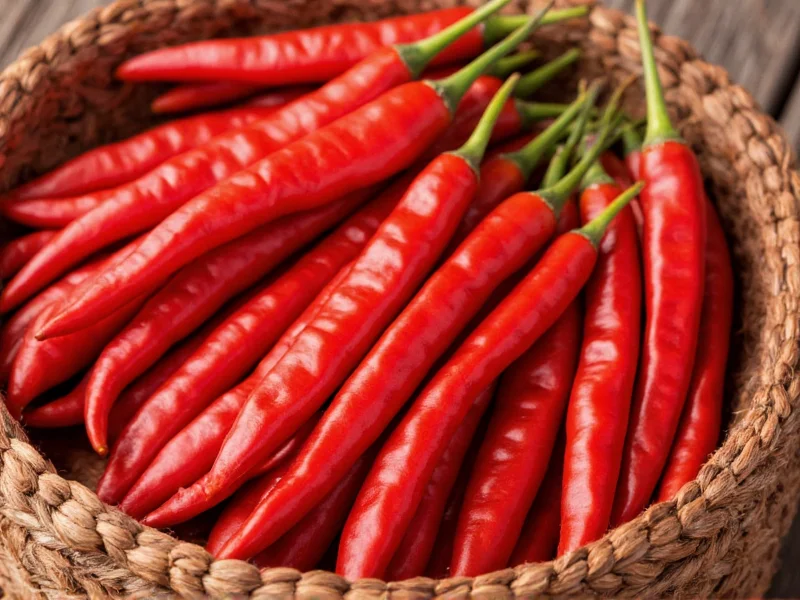Many home cooks and even experienced chefs confuse New Mexico chiles with guajillo peppers due to their similar reddish-brown color when dried and their prevalence in traditional recipes. Understanding the difference between New Mexico chiles and guajillo is essential for authentic flavor development in Mexican and Southwestern dishes. This comprehensive comparison will clarify their unique characteristics to help you make informed choices in your cooking.
New Mexico Chiles: The Southwestern Staple
New Mexico chiles, also known as chile Colorado or chile Nuevo Mexicano, originate from the Hatch Valley region of New Mexico, though they're now grown throughout the American Southwest. These peppers start as long, tapered green chilies (often called 'Hatch chiles' when fresh) that are allowed to ripen to red before being dried.
When dried, New Mexico chiles measure approximately 6-7 inches long with a deep brick-red color. They offer a mild to medium heat level, typically ranging from 500 to 2,500 Scoville Heat Units (SHU). Their flavor profile features earthy, slightly sweet notes with subtle berry undertones and a clean chile flavor. Many consider New Mexico chiles to have a more straightforward 'chile' taste compared to more complex dried peppers.
Culinary applications for New Mexico chiles include:
- Traditional New Mexico red chile sauce
- Stews and braises requiring mild heat
- Rubbed on meats before grilling or roasting
- Blended into adobo sauces
- Soaked and blended for enchilada sauces
Guajillo Chiles: The Mexican Culinary Workhorse
Guajillo chiles (chile guajillo) are the dried form of the mira sol pepper, one of the most commonly used dried chilies in Mexican cooking. Originating in Mexico, these peppers measure 5-6 inches long with a smooth, shiny skin that ranges from reddish-brown to deep mahogany.
Guajillo peppers register between 2,500 and 5,000 SHU on the Scoville scale, making them slightly hotter than most New Mexico chile varieties. Their flavor profile is significantly more complex, featuring notes of berries, tea, and subtle tanginess with a mild heat that builds gradually. Many chefs describe guajillo's flavor as having tamarind-like qualities with a bright, slightly fruity acidity.
Primary culinary uses for guajillo chiles include:
- Mexican moles, particularly mole rojo
- Salsas and adobos requiring complex flavor
- Marinades for carne asada
- Traditional pozole variations
- Blended with other chilies for depth in sauces
Comparing Key Characteristics
| Characteristic | New Mexico Chiles | Guajillo Chiles |
|---|---|---|
| Origin | Southwestern United States (primarily New Mexico) | Mexico |
| Heat Level (SHU) | 500-2,500 (mild to medium) | 2,500-5,000 (medium) |
| Flavor Profile | Earthy, slightly sweet, clean chile flavor | Berry notes, tea-like, tamarind undertones, mild tang |
| Physical Characteristics | 6-7 inches long, deep brick-red, moderate thickness | 5-6 inches long, shiny mahogany, thinner skin |
| Common Culinary Uses | Southwestern red sauces, stews, meat rubs | Mexican moles, salsas, marinades, complex sauces |
| Substitution Potential | Can substitute for mild guajillo applications | Add complexity where New Mexico chiles might be too plain |
Can You Substitute One for the Other?
While you can substitute New Mexico chiles for guajillo (and vice versa) in many recipes, understanding the difference between New Mexico chiles and guajillo will help you make better substitution decisions. When considering can I substitute guajillo for New Mexico chile, examine the recipe's flavor requirements.
Use New Mexico chiles when you want:
- A milder, cleaner chile flavor
- Traditional Southwestern or New Mexican cuisine authenticity
- Recipes where chile flavor should dominate without competing notes
Choose guajillo peppers when you need:
- More complex flavor with berry and tea notes
- Slightly more heat that builds gradually
- Authentic Mexican mole or salsa preparations
- That distinctive tamarind-like tang in sauces
If substituting New Mexico chiles for guajillo, consider adding a small amount of cumin or a touch of vinegar to approximate guajillo's complexity. When replacing guajillo with New Mexico chiles, you might increase the quantity slightly to compensate for the lower heat level, but be cautious as the flavor profile will be noticeably different.
Practical Cooking Guidance
When working with either dried chile, proper preparation significantly impacts the final flavor. Always remove stems and seeds before use, as these contain most of the heat. For both New Mexico chiles vs guajillo applications, toast the dried peppers lightly in a dry skillet for 20-30 seconds per side until fragrant but not burnt. This crucial step enhances their natural flavors.
Rehydration methods affect the final product:
- For sauces requiring smooth texture: Cover toasted chiles with hot water and simmer for 15-20 minutes until pliable
- For rustic salsas: Briefly soak (5-10 minutes) to maintain some texture
- For dry rubs: Grind toasted, dry chiles without rehydrating
Store dried chiles in airtight containers in a cool, dark place. Properly stored, they maintain quality for 6-12 months. For extended storage, keep them in the freezer where they'll retain flavor for up to two years.
Common Confusions and Clarifications
Many people wonder if California chiles are the same as New Mexico chiles. While similar, California chiles (also called chile pasado) are typically milder and slightly sweeter than New Mexico varieties. The confusion arises because both are often labeled simply as 'red chile' in stores.
Another frequent question involves understanding what does guajillo pepper taste like compared to New Mexico chiles. Guajillo offers more complexity with its tea-like, berry notes and subtle tang, while New Mexico chiles provide a cleaner, earthier chile flavor with less nuance but excellent versatility.











 浙公网安备
33010002000092号
浙公网安备
33010002000092号 浙B2-20120091-4
浙B2-20120091-4